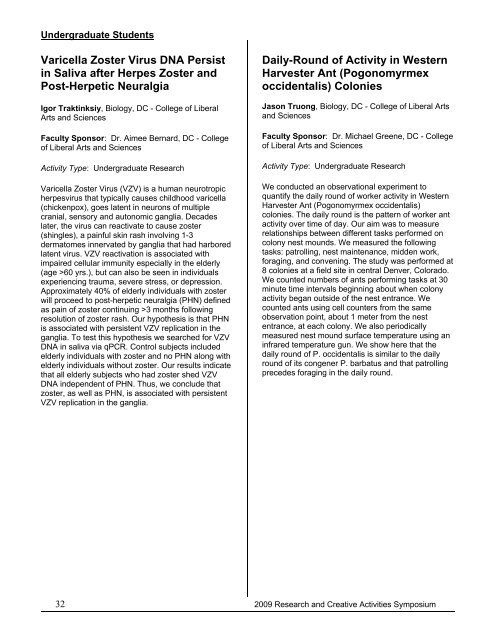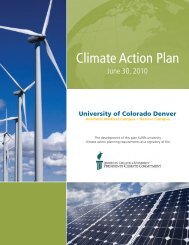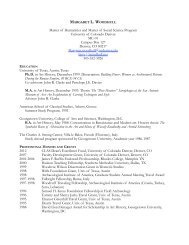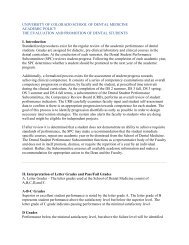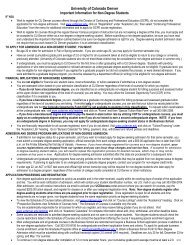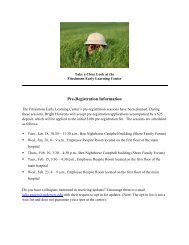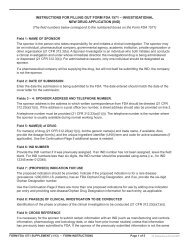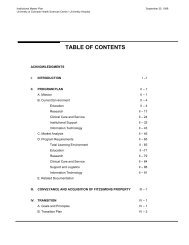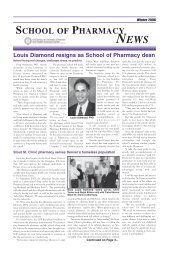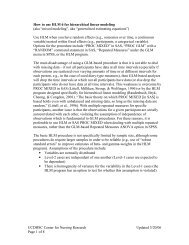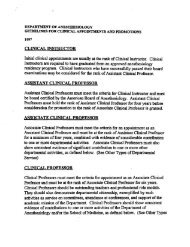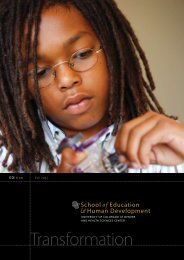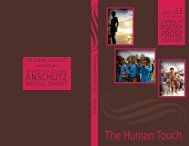2009 Proceedings - University of Colorado Denver
2009 Proceedings - University of Colorado Denver
2009 Proceedings - University of Colorado Denver
Create successful ePaper yourself
Turn your PDF publications into a flip-book with our unique Google optimized e-Paper software.
Undergraduate Students<br />
Varicella Zoster Virus DNA Persist<br />
in Saliva after Herpes Zoster and<br />
Post-Herpetic Neuralgia<br />
Igor Traktinksiy, Biology, DC - College <strong>of</strong> Liberal<br />
Arts and Sciences<br />
Faculty Sponsor: Dr. Aimee Bernard, DC - College<br />
<strong>of</strong> Liberal Arts and Sciences<br />
Activity Type: Undergraduate Research<br />
Varicella Zoster Virus (VZV) is a human neurotropic<br />
herpesvirus that typically causes childhood varicella<br />
(chickenpox), goes latent in neurons <strong>of</strong> multiple<br />
cranial, sensory and autonomic ganglia. Decades<br />
later, the virus can reactivate to cause zoster<br />
(shingles), a painful skin rash involving 1-3<br />
dermatomes innervated by ganglia that had harbored<br />
latent virus. VZV reactivation is associated with<br />
impaired cellular immunity especially in the elderly<br />
(age >60 yrs.), but can also be seen in individuals<br />
experiencing trauma, severe stress, or depression.<br />
Approximately 40% <strong>of</strong> elderly individuals with zoster<br />
will proceed to post-herpetic neuralgia (PHN) defined<br />
as pain <strong>of</strong> zoster continuing >3 months following<br />
resolution <strong>of</strong> zoster rash. Our hypothesis is that PHN<br />
is associated with persistent VZV replication in the<br />
ganglia. To test this hypothesis we searched for VZV<br />
DNA in saliva via qPCR. Control subjects included<br />
elderly individuals with zoster and no PHN along with<br />
elderly individuals without zoster. Our results indicate<br />
that all elderly subjects who had zoster shed VZV<br />
DNA independent <strong>of</strong> PHN. Thus, we conclude that<br />
zoster, as well as PHN, is associated with persistent<br />
VZV replication in the ganglia.<br />
Daily-Round <strong>of</strong> Activity in Western<br />
Harvester Ant (Pogonomyrmex<br />
occidentalis) Colonies<br />
Jason Truong, Biology, DC - College <strong>of</strong> Liberal Arts<br />
and Sciences<br />
Faculty Sponsor: Dr. Michael Greene, DC - College<br />
<strong>of</strong> Liberal Arts and Sciences<br />
Activity Type: Undergraduate Research<br />
We conducted an observational experiment to<br />
quantify the daily round <strong>of</strong> worker activity in Western<br />
Harvester Ant (Pogonomyrmex occidentalis)<br />
colonies. The daily round is the pattern <strong>of</strong> worker ant<br />
activity over time <strong>of</strong> day. Our aim was to measure<br />
relationships between different tasks performed on<br />
colony nest mounds. We measured the following<br />
tasks: patrolling, nest maintenance, midden work,<br />
foraging, and convening. The study was performed at<br />
8 colonies at a field site in central <strong>Denver</strong>, <strong>Colorado</strong>.<br />
We counted numbers <strong>of</strong> ants performing tasks at 30<br />
minute time intervals beginning about when colony<br />
activity began outside <strong>of</strong> the nest entrance. We<br />
counted ants using cell counters from the same<br />
observation point, about 1 meter from the nest<br />
entrance, at each colony. We also periodically<br />
measured nest mound surface temperature using an<br />
infrared temperature gun. We show here that the<br />
daily round <strong>of</strong> P. occidentalis is similar to the daily<br />
round <strong>of</strong> its congener P. barbatus and that patrolling<br />
precedes foraging in the daily round.<br />
32 <strong>2009</strong> Research and Creative Activities Symposium


